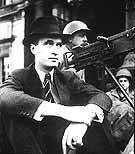
|
|
|

|

|

|

|
|
Click on an image to see a larger, more detailed picture.
|
|
|
|
|
| 1943: Death and Resistance |

|
pg. 443 |

|
|
|
|
| |
 Bergen-Belsen, in Germany, opened in April 1943 as a transit camp. Hence, the majority of its early inmates were non-German Jews, and conditions there were less severe than in other camps. Nonetheless, as the war turned against Germany, and large numbers of prisoners reached the camp after death marches, conditions deteriorated. Around 50,000 died in Bergen-Belsen, approximately 14,000 of them after the camp's liberation.
Bergen-Belsen, in Germany, opened in April 1943 as a transit camp. Hence, the majority of its early inmates were non-German Jews, and conditions there were less severe than in other camps. Nonetheless, as the war turned against Germany, and large numbers of prisoners reached the camp after death marches, conditions deteriorated. Around 50,000 died in Bergen-Belsen, approximately 14,000 of them after the camp's liberation.
Photo: Bildarchiv Preussischer Kulturbesitz
|
 Alfried Krupp was head of the famous German arms manufacturer from the early 1930s to the end of the war. This photograph shows him being taken into custody by American troops prior to being put on trial at Nuremberg. Under his oversight, the Krupp works made extensive use of the cruel and cost-effective slave labor provided by the Third Reich's system of concentration camps. He paid the government for his workers, who received no wages. Thousands died in the appalling conditions that characterized his factories.
Alfried Krupp was head of the famous German arms manufacturer from the early 1930s to the end of the war. This photograph shows him being taken into custody by American troops prior to being put on trial at Nuremberg. Under his oversight, the Krupp works made extensive use of the cruel and cost-effective slave labor provided by the Third Reich's system of concentration camps. He paid the government for his workers, who received no wages. Thousands died in the appalling conditions that characterized his factories.
Photo: Express Newspapers/Archive Phot. F112SRX
|
 These mountains of shoes were once the property of victims gassed at Auschwitz. The Nazis made a considerable effort to exploit their victims economically, and this included seizing any property that could be used in the war effort. At Auschwitz, confiscated property was kept in Effektenkammern (storerooms of movables). The inmates called the area "Canada" because of the sheer amount of loot stored there, which they associated with the riches of Canada.
These mountains of shoes were once the property of victims gassed at Auschwitz. The Nazis made a considerable effort to exploit their victims economically, and this included seizing any property that could be used in the war effort. At Auschwitz, confiscated property was kept in Effektenkammern (storerooms of movables). The inmates called the area "Canada" because of the sheer amount of loot stored there, which they associated with the riches of Canada.
Photo: SYddeutscher Verlag
|
|

|

|

|

|
 April 14, 1943: The slave-labor camp at Siedlce, Poland, is dissolved.
April 14, 1943: The slave-labor camp at Siedlce, Poland, is dissolved.
|
 April 14, 1943: A paper, Program for the Rescue of Jews from Nazi Occupied Europe, is submitted to the Bermuda Conference by the Joint Emergency Committee for European Jewish Affairs; See April 19, 1943.
April 14, 1943: A paper, Program for the Rescue of Jews from Nazi Occupied Europe, is submitted to the Bermuda Conference by the Joint Emergency Committee for European Jewish Affairs; See April 19, 1943.
|
 April 14, 1943: Gerhart Riegner, World Jewish Congress representative in Geneva, suggests that money be deposited in a Swiss account to be paid after the war to enable the 70,000 Romanian Jews previously offered to the Allies to immigrate to Palestine. This comes to be known as the Riegner Plan; See May 1943.
April 14, 1943: Gerhart Riegner, World Jewish Congress representative in Geneva, suggests that money be deposited in a Swiss account to be paid after the war to enable the 70,000 Romanian Jews previously offered to the Allies to immigrate to Palestine. This comes to be known as the Riegner Plan; See May 1943.
|
 April 17-18, 1943: Hitler meets with the Hungarian regent, Admiral Miklós Horthy, at the Klessheim Castle, near Salzburg, Austria, to encourage the deportations of Hungarian Jews. Horthy refuses to acquiesce.
April 17-18, 1943: Hitler meets with the Hungarian regent, Admiral Miklós Horthy, at the Klessheim Castle, near Salzburg, Austria, to encourage the deportations of Hungarian Jews. Horthy refuses to acquiesce.
|
 April 18, 1943: Word leaks into the Warsaw Ghetto of German plans for the ghetto's destruction; See April 19, 1943.
April 18, 1943: Word leaks into the Warsaw Ghetto of German plans for the ghetto's destruction; See April 19, 1943.
|
 April 18, 1943: Nearly 3500 Jews from six Polish towns are transported to Jaworow, Poland, and shot. Resisters who escape to nearby forests are led by Artur Henner and Henry Gleich; most will subsequently be killed by German troops.
April 18, 1943: Nearly 3500 Jews from six Polish towns are transported to Jaworow, Poland, and shot. Resisters who escape to nearby forests are led by Artur Henner and Henry Gleich; most will subsequently be killed by German troops.
|
|
|
|
|
| 1943: Death and Resistance |

|
pg. 443 |

|
|
The Holocaust Chronicle
© 2009 Publications International, Ltd.
|
|
